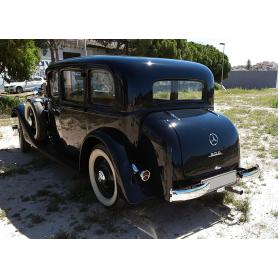No products
Prices are tax excluded
Detailed privacy of the user registry: Here
Legal notice and detailed cookies policy. By continuing to use the site, you accept our use of cookies: Find out more.
302.5
Refurbished
1st Registration: 1936.
Exchange rate: Manual.
National registration. M.
Historical budget depending on the autonomous community.
Color: original, interior: upholstered in leather.
Impeccable. In very good condition.
In perfect working condition.
This product is no longer in stock
Warning: Last items in stock!
Availability date:

Mercedes-Benz 200 W21 Pullman-Limousine 1936. 6/1962cc.
1st Registration: 1936.
Exchange rate: Manual.
National registration. M.
Historical budget depending on the autonomous community.
Color: original, interior: upholstered in leather.
Impeccable. In very good condition.
In perfect working condition.
Recipient :
* Required fields
or Cancel
| State | SOLD |
The Mercedes-Benz W 21 was a six-cylinder passenger car launched in 1933 with the name Mercedes-Benz Typ 200. It was one of several Mercedes-Benz models known, in its own time, as the Mercedes-Benz 200 (or sometimes, in this case, as the Mercedes-Benz 200 type (s)) and therefore in retrospective commonly referred to the use of its Mercedes-Benz factory number, "W21".
A notable success was the popularity of the six-seater "Pullman Limousine" body version for use as a "Kraftdroschke" (taxi). Presumably, it was a simple compliment when, in August 1934, Opel announced a version of its Opel 6 with a long-battle Pullman body. The cars were conceptually similar and even shared an identical wheelbase of 3,050 mm (120 inches), although the Opel was lighter, slightly less powerful and, in terms of performance, a little faster. The biggest difference for the buyer was probably the one that arose when paying for the car. Even the least expensive of the longest-wheelbase Mercedes-Benz 200s, the four-door limousine with a body other than Pullman was included in 1934 with 5,700 marks, while the "Pullman-Limousine" body version began at 6,550 Reichmarks. The "Pullman-Landaulet" (with a cabriolet-style folding hood only on the rear row of seats) or a "Cabrio-Limousine" (Opel) or a "touring car" (Mercedes-Benz), but at all levels the prices indicated they indicate that Mercedes-Benz had a large surcharge on taxi operators.
Mercedes-Benz W 21
4 doors, long version "Limousine" (1936)
Pullman-Limousine 1936. 6 / 1962cc.
The car was a luxury development of the manufacturer's W15, introduced two years earlier. The W21 replaced the Mercedes-Benz W02 (once known as the Mercedes-Benz Typ (e) 200 "Stuttgart") that the company had been manufacturing since 1928.
The car was available as a "passenger car" with a two- or four-door torpedo body, a four-door "limousine" and (from 1935) a two-door (sedan / sedan), a three- or four-seater convertible or as a two-seater sports car.
In 1934 an elongated version of the car was introduced, its wheelbase increased by 350 mm (14 inches) to 3,050 mm (120 inches). Models offered in the longest wheelbase included a six-seater "Pullman-Limousine", a "Pullman-Laundaulet", a "touring car" with a longer torpedo body, a more aerodynamic 4-door "Limousine" / saloon) and three The longest battle Cabriolets are listed respectively as the "Cabriolet A", the "Cabriolet B" and the "Cabriolet D".
Engine and undercarriage
The six-cylinder engine with side valves had a displacement of 1,961 cc which produced a maximum power of 40 hp (29 kW; 39 hp) at 3,200 rpm. 6-cylinder unit installed on the manufacturer's W15 model, but for the W21 the diameter was increased by 5 mm (0.20 in.) To 70 mm (2.8 in.). The declared maximum speed was 98 km / h (61 mph) for the standard length and 95 km / h (59 mph) for long body cars. Power was passed to the rear wheels through a four-speed manual transmission in which the top gear was effectively a gear ratio. The first two proportions were synchronous. The brakes operate on all four wheels via a hydraulic linkage.
Commercial
In terms of features and performance, the W21 represented considerable progress compared to its predecessor, and was priced at the same level, although it was equipped a little simpler and in the form of standard wheelbase was a little smaller. The appearance of a long battle version a year after the introduction of the standard body car was intended in part to address comments that the W21, as it was originally launched, was a bit small to be considered a full-size taxi. complete. However, the standard wheelbase model achieved a production of 9,281 cars during a production of just over three years, while the long battle model achieved 6,341 cars during a shorter production of just over two years.
No customer reviews for the moment.